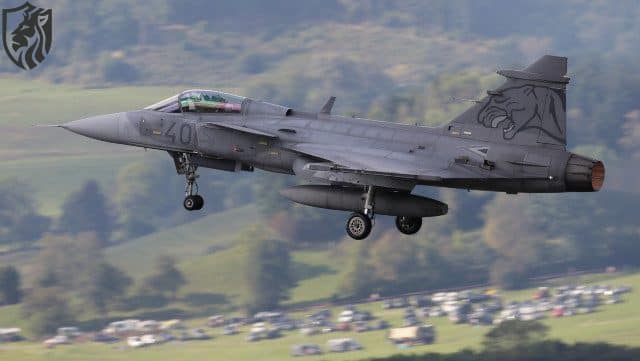
US Blocks Gripen-E Sale to Colombia
The United States has officially moved to block the sale of the General Electric F414-GE-39E engine, a critical component of Sweden’s Saab Gripen E fighter jet, to Colombia’s Air Force (Fuerza Aérea Colombiana). This veto, confirmed by defense analyst SA Defensa on social media, effectively halts any potential deal between Sweden and Colombia, underscoring Washington’s determination to regulate the export of U.S.-manufactured military technology.
Why the U.S. Vetoed the Gripen E Sale to Colombia
Colombia has been actively seeking a modern replacement for its ageing fleet of Kfir fighter bombers, especially given the advanced Su-30MK2 jets operated by neighbouring Venezuela. The Gripen E emerged as a leading candidate due to its cost-effectiveness, extended range, and compatibility with Colombia’s operational requirements.

Saab, the Swedish aerospace giant, has been lobbying hard, highlighting the Gripen E’s ability to patrol vast territories without refuelling and its potential to bolster Colombia’s domestic defense industry.
However, the aircraft’s dependence on the U.S.-made F414 engine means that without Washington’s approval, the sale cannot proceed. This decision reflects broader U.S. strategic goals—controlling the proliferation of American-made defense technology while preserving its influence in Latin America.
The Geopolitical Implications
Washington’s decision to block the sale may strain U.S.-Colombia military ties, which have been historically strong due to collaborations such as Plan Colombia. The veto could push Colombia to reconsider its defense procurement strategy, potentially turning to non-Western suppliers. Speculation is growing that China, which has proposed selling its J-10C fighter jet, could become an alternative source.
The move has also sparked debate over U.S. foreign policy in Latin America. Critics argue that such interventions could weaken U.S. influence, as affected nations may seek greater defense independence or explore options from countries like France and China. Supporters, however, maintain that blocking the Gripen E sale protects American military technology and prevents potential misuse in a geopolitically sensitive region.
Could Peru Be the Next Target?
With Colombia’s Gripen deal effectively blocked, defense analysts now speculate that Peru may face similar obstacles. Lima has also shown interest in the Gripen E as part of its programme to modernise the air force.
Given that the aircraft relies on U.S.-manufactured components, Washington could impose another veto, steering Peru toward purchasing American-made F-16s instead. This approach would align with broader U.S. efforts to maintain regional air superiority through Lockheed Martin’s F-16 Block 70, which has been aggressively marketed across Latin America.
A French Alternative: Dassault Rafale
With increasing uncertainty over U.S. export approvals, the French-made Dassault Rafale is emerging as a potential wildcard. Unlike the Gripen E, the Rafale is powered by French engines and avionics, making it immune to U.S. intervention.
Peru has previously operated Mirage 2000 fighters. They may see the Rafale as an appealing choice. The Rafale avoids American restrictions and has proven combat success. Its advanced sensors and electronic warfare suite boost its capabilities. A diverse weapons loadout makes it a strong rival to the Gripen and F-16. If U.S. pressure on Latin America grows, interest in the Rafale could rise. More nations may choose to keep strategic independence.
The Future of Saab Gripen in Latin America
The Gripen E, a highly versatile multirole fighter developed by Saab, has been a sought-after option for nations looking for an affordable yet advanced combat aircraft. Designed with a delta wing and canard configuration, the Gripen boasts superior agility, modern avionics, and excellent cost-efficiency.

Earlier Gripen A and B models entered service in the 1990s. The upgraded C and D variants followed in the early 2000s. The latest Gripen E/F versions use the powerful General Electric F414G engine. They also feature an advanced AESA radar and a modern electronic warfare suite. These upgrades make the Gripen a strong 4.5-generation fighter. However, its reliance on U.S.-made parts, like the F414 engine, creates export risks.
American restrictions could block the sale of Gripen aircraft in Latin America. If that happens, Saab may need to find alternative suppliers. It could lose markets to Dassault and China’s AVIC if nothing changes.
Conclusion: A Shift in Latin American Air Power?
The sale of the Gripen E to Colombia clearly signals Washington’s intent to control Latin America’s fighter jet market. With Peru in the spotlight, the region’s efforts to modernise its air forces may face significant roadblocks.
As nations reconsider their procurement strategies, alternatives like the Rafale and J-10C could gain traction. Whether such change leads to a diversification of suppliers or further U.S. influence in the region remains to be seen. There is no doubt that Latin America’s defense landscape is undergoing a significant transformation, which could have long-term implications for global arms diplomacy.









